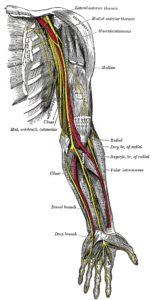A New Treatment for Inflamed Nerves: PIT | The Woodlands, TX
Some people with chronic pain are not candidates for joint replacement or PRP and stem cell therapy. Certain common problems such as trauma, arthritis, sports injury, overuse, occupational or surgical injuries can cause nerve injury. These patients may benefit from PIT, or Perineural Injection Therapy.
What is the Science Underlying this Therapy?
The science is based on an understanding of the role of nerve pain signaling. Pain stimulates a peripheral nerve. The nerve then sends an electrical current to the spinal cord and the brain. The current is created by a flow of molecules with positive or negative charges into and out of the cell via a receptor – a door-like structure in the cell wall. Injury blocks this flow of ions. The nerve then releases pain substances such as nerve growth factor and substance P to alert the brain that something is amiss. These pain chemicals continue to be secreted long after the pain stimulus has stopped. These pain chemicals also prevent local tissue such as muscle, tendon, and ligaments from healing. This can also be defined as neurogenic pain.
How Can the Nerve Become Inflamed?
Nerve inflammation can happen in several ways:
- A nerve can become inflamed as it passes through a tunnel in a bone and is constricted or compressed.
- A nerve can become inflamed from friction as it moves back and forth over the surface of a bone. This often happens in runners and cyclists.
- Overuse can cause scar tissue that entangles or constricts nerves.
- Nerves can become inflamed when they pass through fascia. These areas may be defined as trigger points.
What is the Treatment Method?
- A gentle Dextrose solution is used during the procedure. The dextrose is thought to enter the nerve cell via the receptor restoring normal function to help reset and restore nerves to their normal function.
- Treatments are subcutaneous (under the skin) injections using a short needle. Most patients need 4-6 PITs spaced from 1 to 4 weeks apart.
- The number of injections depends on how many nerves are inflamed, how long they have been inflamed, and how much of the nerve is inflamed.
Results
- Pain can decrease incrementally with each treatment. The goal is relief of all pain and improvement in function.
- In Dr. John Lyftogt’s studies- up to 85% of patients can respond to PIT. Opioid users don’t respond well because opioids compete with dextrose at the receptor site.
Are There any Activity Restrictions?
- Patients should rest the day of the procedure.
- Side effects are rare and include minor bruising. Infection can occur with any injection but is rare with PIT. Allergy has not been reported.
What Conditions can be Treated with PIT?
- Neck pain
- Occipital myalgia
- Tension Headaches
- Migraine headaches
- Thoracic pain
- Fibromyalgia
- Radiculopathy
- Lower back pain
- Shoulder pain
- Knee pain
- Hand osteoarthritis
- Morton’s neuroma
- Coccydynia
Where can I Find a Practitioner who Does this Procedure?
- The physicians at Houston Spine and Sports Medicine have extensive experience performing Perineural Injection treatments for many years.
Call us today at Houston Sports Medicine to schedule an appointment and see if PIT is an option for you!
References
Stiene, H. (2019). Perineural injection therapy (PIT or Lyftogt Technique). Retrieved Feb 27, 2019 from >
https://www.beaconortho.com/blog/perineural-injection-therapy-lyftogt-technique-henry-stiene-m-d/


